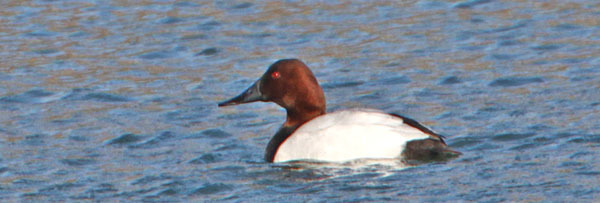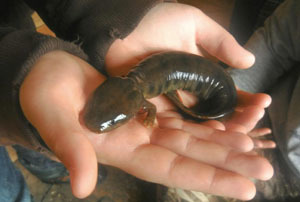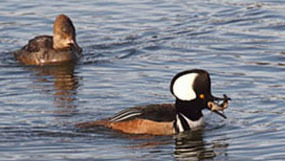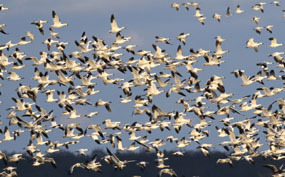Hudson River Almanac 12/09/17 - 12/15/17
The New York State Department of Environmental Conservation sent this bulletin on 12/22/2017 02:00 PM EST |
| DEC Delivers - Information to keep you connected and informed from the NYS Department of Environmental Conservation |
| Share or view as a web page || Update preferences or unsubscribe |
|
|
OVERVIEW Last week featured snowy owls and reports continued coming in this week as well. However, the overwhelming highlight this week was the incredible mass migration of snow geese. This annual late-autumn, early-winter event generally coincides with the first serious winter weather in the northern reaches of the watershed. HIGHLIGHT OF THE WEEK 12/13 – Kingston, HRM 92: Today was that special winter day when the sky seemed filled with shimmering flocks of waves. More than 3,500 snow geese and 800 Canada geese passed over the Forsyth Nature Center in Kingston this afternoon with most of those birds observed in a window between 2:30 p.m. and dusk. NATURAL HISTORY ENTRIES
[Note: one inch = 25.4 millimeters (mm)] [The inland silverside (Menidia beryllina) is native along the Atlantic Coast from Maine to Florida where it is found in coastal waters and estuaries. Inland silverside is more frequently found in the marine waters of the New York Bight than in the lower Hudson where it is far less common than the Atlantic silverside (M. Menidia). J.R. Greeley in his Biological Survey of the Lower Hudson Watershed for the State of New York Conservation Department (1936) designated them as rare. Bob Schmidt did find them in Manitou Marsh (river mile 47) during a 1990s fish survey. DEC’s marine fisheries component recognizes this species as among several that are “of Greatest Conservation Need.” But how uncommon are they? The unavoidable reality is, when faced with a net full of silversides, perhaps we too often assume they are all Atlantic silverside. Tom Lake] 12/9 – Sandy Hook, NJ: I wanted to see if I could land my first-ever striped bass in a snowstorm. I arrived at a deserted Sandy Hook beach just before sundown with two-inches of snow on the ground and more coming down hard. A stiff north wind made the snowflakes feel like little needles on my face. The surf was nicely rough but clear. I saw a small swirl in a deep hole between two sandbars, then another. Then a hit and miss on my fly rod. Then more swirls and I realized I was in the middle of a sea herring blitz. I quickly switched to my spinning rod, tied on a Sabiki rig (no easy feat in the wind) and soon had a half-dozen Atlantic herring (Clupea harengus) on the beach, all of which would soon be marinating in brine. I did manage to catch and release two striped bass in the snowstorm: a 14-incher that grabbed a Sabiki hook and an 18-incher that thumped a bucktail just as I lifted it for another cast. [Sabiki rigs are like a tree with branches, in this case five small hooks branching out on light monofilament leaders. The multiple hook arrangement allows for multiple catches, useful when fish are traveling in schools. Tom Lake] 12/10 – Wappinger Falls, HRM 67: I watched a flock of 25 Canada geese fly over this morning and at the tail end of the formation was a single snow goose. 12/11– Albany County: Tom Williams heard at least three flocks of snow geese flying over in early evening. Tom’s observation would be echoed by several more Hudson-Mohawk Bird Club birders including Robert Pastel, Zach Schwartz-Weinstein, and Jeff Nadler. This evening would be the first significant snow goose migration of the season. 12/11 – New Baltimore, HRM 131.5: After hearing of many snow goose reports from the Hudson-Mohawk Bird Club, from Albany to Saratoga, I went outside at 9:00 p.m. and heard a large flock of snow geese going over.
12/11 – Millbrook, HRM 82: Sometimes the elements of an idyllic setting come together slowly. We were enjoying the glow of last light on the snow-covered stubbled cornfields. The reds turned to pink as the light fell. Out in the middle of one field, a quarter mile away, we could make out three coyotes, tiny black figures, walking slowly in single file across the rise of land. Then we heard the geese. Not Canada geese, different voices. We stood still looking up in the increasing chilly air as at least a dozen snow geese flew low overhead. Unbeknownst to us, today would be a major day of migration for snow geese down the Hudson River flyway.
12/12 – Rensselaer-Columbia counties, HRM142-129: It was interesting to hear the changeable sounds of snow underfoot across three days. Two days ago we had newly fallen snow and it was dry and fluffy. I call it “Utah Snow” and it makes no sound under my boots since this type of snow absorbs sound waves. Yesterday, when the temperature of the snow was colder than 14 degrees Fahrenheit the snow beneath my feet was not melted by the pressure of my boots. Instead, my boots crushed the ice crystals making a squeaking sound that I call ”Cornstarch Snow,” which is what Foley artists [creating sounds for film] use to make the sound effect of walking in snow. Today, with the air temperature much colder, freezing rain had hardened the snow on the trails. My footsteps were a careful shuffle that broke through the layer of snow causing a loud crunch. I call this “Times Square Snow,” raucous and harsh. 12/12 – Yonkers, HRM 18: We went out to haul our net in cool, drizzly weather in early afternoon at the Center for the Urban River at Beczak. We were struck by the volume of fallen leaves in the water that made seining much heavier than normal. Across six hauls we landed 15 fish, dominated by young-of-the year (YOY). Among them were YOY Atlantic silverside (50-70 mm) and Atlantic menhaden (45-70 mm).Two year classes of striped bass were also present, YOY (75 mm) and yearlings (120-160 mm). The river was 44 degrees Fahrenheit and the salinity was 10.0 ppt. 12/13 – Ulster Park, HRM 87: Just as the sun was setting today, a flock of 200 snow geese flew over our home. 12/13 – Croton Bay, HRM 34-33: The falling tide was half-way out being pushing seaward by strong northwest winds gusting to 40 miles-per-hour. Between the whitecaps and swells we could make out discreet rafts of waterfowl, most with 25-50 birds, including bufflehead, common goldeneye, ruddy ducks, scaup (possibly lesser scaup), as well as 100 canvasbacks (both hens and drakes). The canvasbacks were likely some of the estimated 200 counted here a week ago by Larry Trachtenberg. 12/14 – Saratoga County, HRM 182: We were out early on Saratoga Lake for the morning part of the Saratoga Christmas Bird Count. Snow flurries gave way to clearing and plentiful sun by late morning. We counted 40 species including Canada geese (1490), snow geese (2), mallard (429), American black duck (41), common merganser (262), red-breasted merganser (5), hooded merganser (2), common goldeneye (251), mixed greater and lesser scaup (150), redhead duck (2), bufflehead (57), and common loon (2). Raptors sighted included bald eagles (2) and one peregrine falcon. 12/14 – Rensselaer County, HRM 162: Several thousand snow geese passed over Tomhannock Reservoir late this afternoon. There was also an estimated couple thousand common mergansers and a few bald eagles. 12/14 – Albany County, HRM 146: An enormous flock of snow geese – at least 400 birds – flew over my home in Meadowdale today. In late afternoon, another similar-sized flock passed over the Helderberg Escarpment.
[We call them “high-flyers” because that is what they do. Skeins of migrating geese, Canada and snow geese, often fly miles high, strung out in Vs and large check-marks, always in flux, the birds constantly changing their position creating geometrics of the sky. It always reminds me of volleyball players switching after every point. A strong north breeze was pushing this flock south allowing the geese to save energy. Tom Lake] 12/15 – Hudson Valley: In a theme of looking for small favors on these frigid days, we've added one minute to the time of sunset over the last week. 12/15 – Cohoes, HRM 153: This morning, Tristan Lowery and Bernice Gawron spotted a snowy owl flying over gate A6 at the Albany International Airport. 12/15 – Esopus Meadows, HRM 87: I watched a huge flock of snow geese passing over, perfectly alighted by the sun. Right in the middle of the flock was a single “blue goose,” a snow goose color-morph with a dark body and white head. I had never seen one before. 12/15 – Norrie Point, HRM 85: We spotted an adult bald eagle this afternoon from across the cove at the Norrie Point Environmental Education Center feeding on something just above the tide line. Shortly, a second adult eagle arrived. Judging by the fact that there was no contention, we could assume it was a mated pair. We watched this through binoculars but it was difficult to see what they were feeding on. When the two eagles flew off, I sneaked around the shoreline to discover the identity of the meal. All that was left was the large head of a channel catfish. WINTER 2018 NATURAL HISTORY PROGRAM Wednesday, January 10, 2018 from 12:00 noon - 1:00 p.m. Saturday, February 24 - 1:00 p.m. HUDSON RIVER MILES The Hudson is measured north from Hudson River Mile 0 at the Battery at the southern tip of Manhattan. The George Washington Bridge is at HRM 12, the Tappan Zee 28, Bear Mountain 47, Beacon-Newburgh 62, Mid-Hudson 75, Kingston-Rhinecliff 95, Rip Van Winkle 114, and the Federal Dam at Troy, the head of tidewater, at 153. The tidal section of the Hudson constitutes a bit less than half the total distance – 315 miles – from Lake Tear of the Clouds to the Battery. Entries from points east and west in the watershed reference the corresponding river mile on the mainstem. TO CONTRIBUTE YOUR OBSERVATIONS OR TO SUBSCRIBE The Hudson River Almanac is compiled and edited by Tom Lake and emailed weekly by DEC's Hudson River Estuary Program. Share your observations by e-mailing them to trlake7@aol.com. To subscribe to the Almanac (or to unsubscribe), use the links on DEC's Hudson River Almanac or DEC Delivers web pages. Discover New York State Conservationist - the award-winning, advertisement-free magazine focusing on New York State's great outdoors and natural resources. Conservationist features stunning photography, informative articles and around-the-state coverage. Visit the Conservationist webpage for more information. USEFUL LINKS National Oceanic and Atmospheric Administration online tide and tidal current predictions are invaluable when planning Hudson River field trips. For real-time information on Hudson River tides, weather and water conditions from twelve monitoring stations, visit the Hudson River Environmental Conditions Observing System website. Information about the Hudson River Estuary Program is available on DEC's website at http://www.dec.ny.gov/lands/4920.html . Smartphone app available for New York outdoor enthusiasts! Copies of past issues of the Hudson River Almanac, Volumes II-VIII, are available for purchase from the publisher, Purple Mountain Press, (800) 325-2665, or email purple@catskill.net
|

 Hudson River Almanac
Hudson River Almanac 12/9 – Kowawese, HRM 59: The river temperature had fallen back to 41 degrees Fahrenheit but salinity had rebounded to 1.0 parts-per-thousand (ppt). As we set the seine, the bone-chilling cold penetrated our waders like icy fingers grabbing our legs. Our hauls were predictable and after a half-dozen that featured local fish such as spottail shiners, tessellated darters, and white perch, we announced “last haul.” Given the date and the environmental conditions, it could well be our last of the season. As we slid the net up on the sand we saw one tiny pulse in the seine, a single fish, but it was a special fish. We had captured an inland silverside (68 millimeters (mm)). (Photo of inland silverside courtesy of Doug Carlson)
12/9 – Kowawese, HRM 59: The river temperature had fallen back to 41 degrees Fahrenheit but salinity had rebounded to 1.0 parts-per-thousand (ppt). As we set the seine, the bone-chilling cold penetrated our waders like icy fingers grabbing our legs. Our hauls were predictable and after a half-dozen that featured local fish such as spottail shiners, tessellated darters, and white perch, we announced “last haul.” Given the date and the environmental conditions, it could well be our last of the season. As we slid the net up on the sand we saw one tiny pulse in the seine, a single fish, but it was a special fish. We had captured an inland silverside (68 millimeters (mm)). (Photo of inland silverside courtesy of Doug Carlson) 12/11 – Norrie Point, HRM 85: We caught another mudpuppy at Norrie Point. It was at the same place and about the same size as last week’s catch. We know this one was not the first one since the one we caught six days ago was still being acclimated back to the cold. The first mudpuppy had a banded killifish in the minnow pot with it. The second mudpuppy was accompanied by a spottail shiner. Was the mudpuppy seeking a cozy respite, or a meal? Killifish and minnows are certainly on their menu. [From 2001 through 2017, we have had eleven records of mudpuppies in the Hudson River (river miles 159 to 85) ranging in size from 350-360 mm in length.] (Photo of mudpuppy courtesy of Chris Bowser)
12/11 – Norrie Point, HRM 85: We caught another mudpuppy at Norrie Point. It was at the same place and about the same size as last week’s catch. We know this one was not the first one since the one we caught six days ago was still being acclimated back to the cold. The first mudpuppy had a banded killifish in the minnow pot with it. The second mudpuppy was accompanied by a spottail shiner. Was the mudpuppy seeking a cozy respite, or a meal? Killifish and minnows are certainly on their menu. [From 2001 through 2017, we have had eleven records of mudpuppies in the Hudson River (river miles 159 to 85) ranging in size from 350-360 mm in length.] (Photo of mudpuppy courtesy of Chris Bowser) 12/12 – Newcomb, HRM 302: The feeder-bird switch was finally turned "On" today. I have been averaging about 17 individual birds at my feeders this fall and winter, with about a half-dozen species. Today, with just a covering of snow on the ground and a winter storm just missing us, the birds were at the feeders. There were close to 50 individuals including dark-eyed juncos, American goldfinches, purple finches, and pine siskins. Three cold-looking American robins were also feeding on what was left of the crab apples. Lakes were iced-over with a little bit of open water at the outlet of Rich Lake harboring some hooded mergansers and a bufflehead. (Photo of hooded merganser courtesy of Terry Hardy)
12/12 – Newcomb, HRM 302: The feeder-bird switch was finally turned "On" today. I have been averaging about 17 individual birds at my feeders this fall and winter, with about a half-dozen species. Today, with just a covering of snow on the ground and a winter storm just missing us, the birds were at the feeders. There were close to 50 individuals including dark-eyed juncos, American goldfinches, purple finches, and pine siskins. Three cold-looking American robins were also feeding on what was left of the crab apples. Lakes were iced-over with a little bit of open water at the outlet of Rich Lake harboring some hooded mergansers and a bufflehead. (Photo of hooded merganser courtesy of Terry Hardy) 12/14 – Town of Wappinger, HRM 67: In mid-morning and again in late afternoon we heard geese, their calls racing down the wind. This morning there were three flocks of high-flyer snow geese, well more than 100 birds, their whiteness starkly contrasting with the blue sky. In late afternoon four more V formations passed over, the setting sun lighting them up. (Photo of snow geese courtesy of Tom Lake)
12/14 – Town of Wappinger, HRM 67: In mid-morning and again in late afternoon we heard geese, their calls racing down the wind. This morning there were three flocks of high-flyer snow geese, well more than 100 birds, their whiteness starkly contrasting with the blue sky. In late afternoon four more V formations passed over, the setting sun lighting them up. (Photo of snow geese courtesy of Tom Lake)